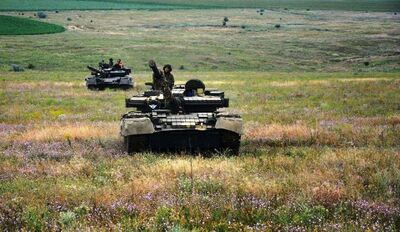Operation Aspis: Difference between revisions
mNo edit summary |
No edit summary |
||
| Line 31: | Line 31: | ||
| casualties2 = 22,187 killed </br> 62,316 wounded </br> 8,000 captured </br> | | casualties2 = 22,187 killed </br> 62,316 wounded </br> 8,000 captured </br> | ||
| notes = | | notes = | ||
| campaignbox = | | campaignbox = {{Campaignbox Zemplen War}} | ||
}} | }} | ||
Revision as of 21:39, 22 September 2020
Operation Aspis was a major strategic offensive launched by the Syaran Commonality Armed Forces against Ruvelka between 18 September to 8 October 2008. The objective of the offensive was to destroy the Ruvelkan military as a fighting force and force Ruvelka to sue for peace.
After fighting had broken out between Syara and Ruvelka in the summer of 2008 over the disputed Zemplen Region, the SCAF launched a number of limited offensives that had secured most of the disputed regions on the Ruvelkan-Syaran border. The August Offensives had driven the Ruvelkan Imperial Army back but the Ruvelkan government of Chancellor Edviná Molnár declared that Ruvelka would not seek peace so long as Ruvelkan soil was occupied by Syaran troops. With Ruvelkan refusal to negotiate, Central Command of the SCAF suggested launching a major offensive designed to destroy the IAFR as a unified military, which would force Ruvelka to sue for peace once it could no longer defend it's territory. Syaran military leadership had been encouraged by Syaran success in the Imerti Conflict and the fighting thus far, all of which had largely demonstrated Syaran superiority in combined arms and operations.
The Syaran Government of Executive Dragomir Zhelev went to great lengths to portray the operation as an ultiamtely defensive effort, going so far as to name the operation Aspis, meaning 'shield'. The SCAF insisted that Aspsi was not an invasion proper but a measure meant to deny Ruvelka the ability to threaten Syaran territorial integrity. In particular Syara hoped to avoid allusion to the invasion of Ruvelka that had sparked the Siduri War. Despite Syaran efforts the operation resulted in widespread international comdemnation from the Common Sphere, Mansuriyyah, and Acrea.
Syaran forces consisting of Army Group's Alpha, Beta, and Gamma launched their offensive on 18 September, striking along the entire 600 mile border. The SCAF employed heavy usage of artillery and air strikes in an attempt to disrupt Ruvelkan movement and response, while ground forces attempted to encircle large formations of Ruvelkan troops along the border. Although the Syarans were able to inflict heavy losses on the Ruvelkan forces and seize hundreds of square kilometers of territory the overall objective of destroying the Imperial Armed Forces failed; Syaran Central Command seriously understimated the depth of Ruvelkan reserves, and the rough terrain of Ruvelka's interior proved illsuited towards fast moving mechanized maneuvers. By the end of September Army Group's Beta and Gamma had been halted, while in the north Army Group Alpha continued to advance until it's defeat at the Battle of Sarud, which is usually used to indiciate the end of Operation Aspis.
Although Syara had seized considerable territory, Aspis was ultimately deemed a failure. Ruvelkan forces had suffered over 120,000 troops killed, wounded, or captured, but Syaran forces themselves suffered over 95,000 casualties, including many of Syara's best trained and armed formations. The invasion also earned Syara international comdenation, resulting in several nations to begin supplying Ruvelka with armarments and support. Aspis resulted in a lull in the fighting as both sides exhausted their pre-war stockpiles of ammunition and fuel, though more local offensives continued on both sides until the launch of the Ruvelkan Winter Counter-Offensive.
